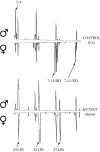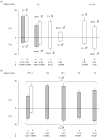A single mutation alters production and discrimination of Drosophila sex pheromones
- PMID: 15705556
- PMCID: PMC1634977
- DOI: 10.1098/rspb.2004.2971
A single mutation alters production and discrimination of Drosophila sex pheromones
Abstract
The evolution of communication is a fundamental biological problem. The genetic control of the signal and its reception must be tightly coadapted, especially in inter-individual sexual communication. However, there is very little experimental evidence for tight genetic linkage connecting the emission of a signal and its reception. We found that a single genomic transposon inserted in the desatl gene of Drosophila melanogaster simultaneously affected the emission and the perception of sex-specific signals. This mutation greatly decreased the production of unsaturated hydrocarbons on the cuticle of mature flies of both sexes. These substances represent the sex pheromones necessary for mate discrimination: control males could not discriminate the sex of mutant desatl flies. Moreover, mutant males were unable to discriminate the sex pheromones of con-trol flies. Expression of desatl was found in the peripheral tissues that produce and detect sex pheromones. Excision of the transposon rescued both the production and discrimination phenotypes, but the two effects did not always coincide. This indicates that the emission and perception of pheromones are coded by differ-ent products of the same gene, reflecting the pleiotropic activity of desatl .
Figures




Similar articles
-
Expression of a desaturase gene, desat1, in neural and nonneural tissues separately affects perception and emission of sex pheromones in Drosophila.Proc Natl Acad Sci U S A. 2012 Jan 3;109(1):249-54. doi: 10.1073/pnas.1109166108. Epub 2011 Nov 23. Proc Natl Acad Sci U S A. 2012. PMID: 22114190 Free PMC article.
-
A mutation with major effects on Drosophila melanogaster sex pheromones.Genetics. 2005 Dec;171(4):1617-28. doi: 10.1534/genetics.104.033159. Epub 2004 Oct 16. Genetics. 2005. PMID: 15489528 Free PMC article.
-
desat1 and the evolution of pheromonal communication in Drosophila.Ann N Y Acad Sci. 2009 Jul;1170:502-5. doi: 10.1111/j.1749-6632.2009.03927.x. Ann N Y Acad Sci. 2009. PMID: 19686185
-
Cuticular hydrocarbons: their evolution and roles in Drosophila pheromonal communication.Behav Genet. 2005 May;35(3):279-95. doi: 10.1007/s10519-005-3220-5. Behav Genet. 2005. PMID: 15864443 Review.
-
The pheromonal role of cuticular hydrocarbons in Drosophila melanogaster.Bioessays. 1997 Apr;19(4):353-8. doi: 10.1002/bies.950190413. Bioessays. 1997. PMID: 9136633 Review.
Cited by
-
Interplay between male quality and male-female compatibility across episodes of sexual selection.Sci Adv. 2023 Sep 29;9(39):eadf5559. doi: 10.1126/sciadv.adf5559. Epub 2023 Sep 29. Sci Adv. 2023. PMID: 37774022 Free PMC article.
-
Sensory integration regulating male courtship behavior in Drosophila.PLoS One. 2009;4(2):e4457. doi: 10.1371/journal.pone.0004457. Epub 2009 Feb 13. PLoS One. 2009. PMID: 19214231 Free PMC article.
-
The genetic basis of female pheromone differences between Drosophila melanogaster and D. simulans.Heredity (Edinb). 2019 Jan;122(1):93-109. doi: 10.1038/s41437-018-0080-3. Epub 2018 May 19. Heredity (Edinb). 2019. PMID: 29777168 Free PMC article.
-
Steroid Hormone Signaling Is Essential for Pheromone Production and Oenocyte Survival.PLoS Genet. 2016 Jun 22;12(6):e1006126. doi: 10.1371/journal.pgen.1006126. eCollection 2016 Jun. PLoS Genet. 2016. PMID: 27333054 Free PMC article.
-
Expression of a desaturase gene, desat1, in neural and nonneural tissues separately affects perception and emission of sex pheromones in Drosophila.Proc Natl Acad Sci U S A. 2012 Jan 3;109(1):249-54. doi: 10.1073/pnas.1109166108. Epub 2011 Nov 23. Proc Natl Acad Sci U S A. 2012. PMID: 22114190 Free PMC article.
References
-
- Antony C., Jallon J.M. The chemical basis for sex recognition in Drosophila melanogaster. J. Insect. Physiol. 1982;28:873–880.
-
- Blows M.W. Evolution of the genetic covariance between male and female components of mate recognition: an experimental test. Proc. R. Soc. B. 1999;266:2169–2174. doi:10.1098/rspb.1999.0904 - DOI - PMC - PubMed
-
- Boake C. Coevolution of senders and receivers of sexual signals: genetic coupling and genetic correlations. Trends Ecol. Evol. 1991;6:225–227. - PubMed
-
- Boll W., Noll M. The Drosophila Pox neuro gene: control of male courtship behavior and fertility as revealed by a complete dissection of all enhancers. Development. 2002;129:5667–5681. - PubMed
Publication types
MeSH terms
Substances
LinkOut - more resources
Full Text Sources
Molecular Biology Databases
Research Materials
Miscellaneous

